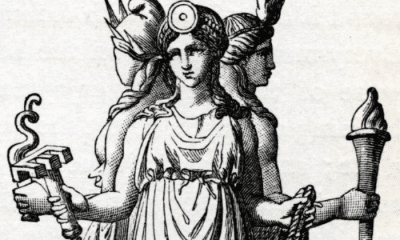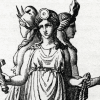Greek
Who is Arachne?
The weaver Arachne was turned into a spider for challenging Athena, but does the story have a deeper meaning than to explain why webs are spun?
Arachne was a human weaver who refused to give Athena credit for her skill. She challenged the goddess to a weaving contest.
While Arachne did not lose the contest due to a lack of expertise, her arrogance and the subject of the tapestry she created angered the goddess even more. She tried to kill herself to escape Athena’s wrath, but the goddess turned her into a spider before she died.
Such stories of transfiguration and the punishment of arrogance are common in Greek mythology, but the story was not actually a Greek legend.
It was created in the 1st century AD by the Roman poet Ovid. It was one of his Metamorphoses, a collection that compiled both old and original stories of magical transformation.
Ovid’s story, however, is more than an imitation of earlier forms. Close reading reveals that Ovid may have shown some of himself in the story of Arachne’s refusal to bow to tyrannical authority.
Arachne and the Weaving Contest
According to the Roman poet Ovid, Arachne was a young Lydian woman who once angered the goddess Athena.
Arachne’s father was a skilled dyer who created the rich purple cloth Lydia was prized for. While he made dyes, his daughter spun the wool and created beautiful tapestries from the richly-colored fleece.
Arachne was of humble birth but earned great fame for her skills. She became known as one of the greatest weavers in the world.
She was so graceful in her work that nymphs would travel to watch her as she wove. Her fingers moved almost too quickly to see and she swayed as though she were dancing while she worked at her loom.
The nymphs claimed Athena, as the goddess of weaving, had graced the young woman with a remarkable gift. Arachne, however, denied that any god was responsible for her skill, and claimed she had learned from hard work alone.
Athena agreed that the girl had great talent, but she was offended that Arachne refused to give her proper credit as the patroness of weavers. Athena decided to pay the Lydian girl a visit to see for herself whether the human’s arrogance was as great as the nymphs had reported it to be.
Athena disguised herself as an old, feeble peasant woman and went to Arachne’s workshop to meet the girl herself.
In this disguise, the goddess told Arachne to be sure to give proper respect to Athena for granting her such exceptional skill. She was entitled to praise for her work, but it would be unwise to forget that the gods were ultimately responsible for her success.
Arachne insulted the old woman and claimed that if Athena herself wanted a contest she would be the victor. Athena instantly dropped her disguise and accepted the arrogant girl’s challenge.
Arachne still refused to stand down, so both took places at their looms and attempted to outdo one another.
Athena quickly wove a beautiful tapestry showing the glory of the gods. It depicted her victory over Poseidon in their contest for the patronage of the city of Athens, with Zeus enthroned in the center as the judge.
In each of the corners, Athena included a scene of other humans who were punished for arrogance in an attempt to intimidate her opponent.
Arachne worked just as quickly, but showed much different images. Rather than showing the power and wisdom of the gods, she showed them at their worst.
Her tapestry depicted the times when the gods used deceit and disguises to seduce, or assault, the women they desired. Athena’s father, Zeus, was featured no less than eight times in his many infidelities.
When they had finished, Athena could not deny that Arachne’s work was technically flawless. The weaving was perfectly done and the figures were so skillfully rendered that they almost looked lifelike.
The goddess was infuriated, however, by the subject matter. The gods, particularly her own father, were shown as brutal liars rather than with the respect they demanded.
Angered by both the scenes shown and her own failure to decisively beat the mortal weaver, Athena tore Arachne’s work to shreds.
Arachne herself had remained defiant, but broke down upon realizing the extent of the goddess’s wrath. She gathered up the ruined threads of her tapestry and used them to hang herself rather than face further punishment and shame.
The goddess, although she was still angry, was moved to pity. She quickly saved Arachne moments before death, but doomed the weaver to hang by a single thread forever.
Athena sprinkled magical herbs procured from Hecate on the girl, who began to undergo a horrific metamorphosis.
Her hair fell out, her nose and ears disappeared. Her body shrunk and her arms disappeared, her fingers moving to her sides in the form of long legs.
Arachne was changed into a spider, doomed to spend her entire life weaving and hanging by a cord just as she had done in her final moments as a human. Athena had spared her from death in recognition of her talent, but sentenced her to a terrible punishment for her disrespect.
My Modern Interpretation
The story of Arachne is well-known, but was not written with Greek audiences in mind.
It was first recorded, and apparently invented, by the Roman poet Ovid. It was one of many tales, both traditional and newly-imagined, included in his Metamorphoses.
In form, the newer story blended well with the more established myths of ancient Greece. In both form and function, it kept with older traditions.
It was one of many stories in which the transformation of a human or nymph was used to explain the existence of a particular animal or plant. Such tales served not only to explain the natural world but also often carried a moral lesson.
It was also one of many stories in which an Olympian, challenged to a contest of skill by a lesser being, punished their opponent for hubris even if they were technically matched. The satyr Marsyas, for example, was killed for challenging Apollo to a music contest and winning through a trick.
While Ovid’s story of a contest fit well in Greek tradition, some historians view it as a tale with a uniquely Roman meaning.
Ovid wrote Metamorphoses during the reign of Augustus, the first emperor of Rome. His poems had caused conflict with the socially conservative emperor, who had established new laws governing morality in the arts and social life.
Ovid’s work was often censored under Imperial law, and he responded by writing works that were more intentionally inflammatory. The same year Metamorphoses was published, Ovid was exiled from Rome under Imperial decree.
The story of Arachne seems to contain many allusions to the conflict between Ovid and the emperor.
Arachne’s father, for example, was the maker of the same Lyrian purple dye that was valued by the Roman aristocracy. Under the sumptuary laws of Augustus, senators could wear limited amounts of the color but only the emperor was permitted to wear robes of pure Lyrian purple.
Arachne used the color of the emperor to show the gods in a negative light. Like Ovid, she had used her craft to highlight the shortcomings of those in power rather than give them praise.
Ovid’s weaver did not lose her contest against Athena because of a lack of skill, but because she challenged those in power. Modern readers find an easy parallel between Arachne’s defiance and that of the poet who created her.
In Ovid’s time, weaving was often used as a metaphor for writing poetry or composing music. Similar language is sometimes used today when we say someone spins or weaves a story, but the analogy would have been even more quickly recognized by readers in the Roman world.
It is a reasonable interpretation, then, to see Arachne the weaver as a stand-in for Ovid the poet. Both were punished not for a lack of skill, but because they used their skills to challenge and defy those in authority.
In Summary
The story of Arachne involves a human weaver who challenges Athena to a weaving contest. While her skills are equal to those of the goddess, her decision to show scenes of the gods as lustful and deceptive men incurred Athena’s wrath.
Arachne attempted to hang herself, but was saved at the last minute by Athena. She was transformed into a spider both as a punishment for her hubris and in recognition of her weaving skills.
While the story contains many elements typical in Greek mythology, it was actually the creation of a Roman poet. Ovid included the original tale in his Metamorphoses, which was published in 8 AD.
Arachne’s story may seem like an ancient caution against arrogance, but both modern and Latin readers could also interpret it as one in which an artist is punished for their content and defiance rather than a lack of skill.
The character is, in fact, probably an allegory for Ovid himself. The poet was banished from Rome in the same year his work was published for his continual defiance of Emperor Augustus’s morality laws.
Ovid wrote a story of a person punished for defying authority to reflect his own experiences. Like Arachne, he used his skills to point out the flaws of those in power and assert his own abilities rather than glorify the powerful.



